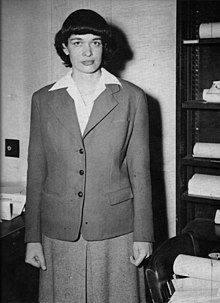Leona Woods | |
|---|---|
 Woods at the University of Chicago in 1946 | |
| Born | Leona Harriet Woods August 9, 1919 La Grange, Illinois, U.S. |
| Died | November 10, 1986 (aged 67) Santa Monica, California, U.S. |
| Education | University of Chicago (BS, MS, PhD) |
| Known for | Involvement in the Manhattan Project |
| Spouses | |
| Children | 2 |
| Scientific career | |
| Fields | Physics |
| Institutions | Manhattan Project |
| Doctoral advisor | Robert Mulliken |
| Other academic advisors | Stanisław Mrozowski |
Leona Harriet Woods (August 9, 1919 – November 10, 1986), later known as Leona Woods Marshall and Leona Woods Marshall Libby, was an American physicist who helped build the first nuclear reactor and the first atomic bomb.
At age 23, she was the youngest and only female member of the team which built and experimented with the world's first nuclear reactor (then called a pile), Chicago Pile-1, in a project led by her mentor Enrico Fermi. In particular, Woods was instrumental in the construction and then utilization of geiger counters for analysis during experimentation. She was the only woman present when the reactor went critical. She worked with Fermi on the Manhattan Project, and she subsequently helped evaluate the cross section of xenon, which had poisoned the first Hanford production reactor when it began operation.
After the war, she became a fellow at Fermi's Institute for Nuclear Studies at the University of Chicago. She later worked at the Institute for Advanced Study in Princeton, New Jersey, the Brookhaven National Laboratory, and New York University, where she became a professor in 1962. Her research involved high-energy physics, astrophysics and cosmology. In 1966 she divorced John Marshall and married Nobel laureate Willard Libby. She moved as a professor to the University of Colorado, and was a staff member at RAND Corporation. In later life she became interested in ecological and environmental issues, and she devised a method of using the isotope ratios in tree rings to study climate change. She was a strong advocate of food irradiation as a means of killing harmful bacteria.